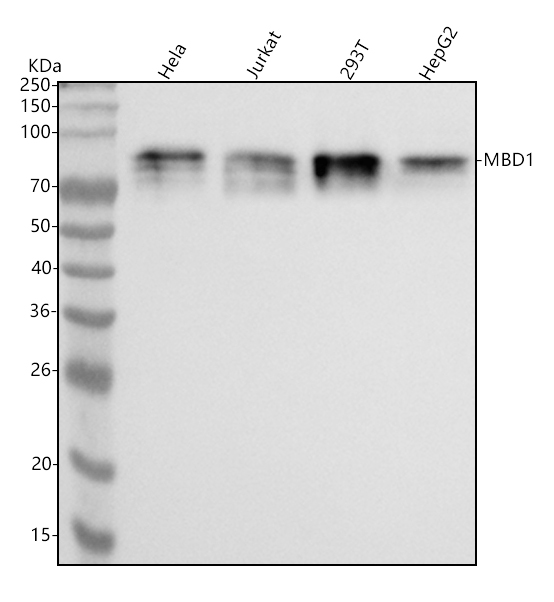Anti-MBD1 Monoclonal Antibody
- SPECIFICATION
- CITATIONS
- PROTOCOLS
- BACKGROUND

Application
| WB, IHC, IF, ICC, IP |
|---|---|
| Primary Accession | Q9UIS9 |
| Host | Rabbit |
| Isotype | Rabbit IgG |
| Reactivity | Human |
| Clonality | Monoclonal |
| Format | Liquid |
| Description | Anti-MBD1 Monoclonal Antibody . Tested in WB, IHC, ICC/IF, IP applications. This antibody reacts with Human. |
| Gene ID | 4152 |
|---|---|
| Other Names | Methyl-CpG-binding domain protein 1, CXXC-type zinc finger protein 3, Methyl-CpG-binding protein MBD1, Protein containing methyl-CpG-binding domain 1, MBD1 (HGNC:6916), CXXC3, PCM1 |
| Calculated MW | 67, 80 kDa |
| Application Details | WB 1:500-1:1000 IHC 1:50-1:200 ICC/IF 1:50-1:200 IP 1:20 |
| Contents | Rabbit IgG in phosphate buffered saline, pH 7.4, 150mM NaCl, 0.02% sodium azide and 50% glycerol, 0.4-0.5mg/ml BSA. |
| Clone Names | Clone: ACAI-13 |
| Immunogen | A synthesized peptide derived from human MBD1 |
| Purification | Affinity-chromatography |
| Storage | Store at -20°C for one year. For short term storage and frequent use, store at 4°C for up to one month. Avoid repeated freeze-thaw cycles. |
| Name | MBD1 (HGNC:6916) |
|---|---|
| Synonyms | CXXC3, PCM1 |
| Function | Transcriptional repressor that binds CpG islands in promoters where the DNA is methylated at position 5 of cytosine within CpG dinucleotides. Binding is abolished by the presence of 7-mG that is produced by DNA damage by methylmethanesulfonate (MMS). Acts as transcriptional repressor and plays a role in gene silencing by recruiting ATF7IP, which in turn recruits factors such as the histone methyltransferase SETDB1. Probably forms a complex with SETDB1 and ATF7IP that represses transcription and couples DNA methylation and histone 'Lys-9' trimethylation. Isoform 1 and isoform 2 can also repress transcription from unmethylated promoters. |
| Cellular Location | Nucleus. Nucleus matrix. Nucleus speckle Chromosome Note=Nuclear, in a punctate pattern (PubMed:12711603). Associated with euchromatic regions of the chromosomes, with pericentromeric regions on chromosome 1 and with telomeric regions from several chromosomes (PubMed:10454587, PubMed:10648624). |
| Tissue Location | Widely expressed.. |

Thousands of laboratories across the world have published research that depended on the performance of antibodies from Abcepta to advance their research. Check out links to articles that cite our products in major peer-reviewed journals, organized by research category.
info@abcepta.com, and receive a free "I Love Antibodies" mug.
Provided below are standard protocols that you may find useful for product applications.
If you have used an Abcepta product and would like to share how it has performed, please click on the "Submit Review" button and provide the requested information. Our staff will examine and post your review and contact you if needed.
If you have any additional inquiries please email technical services at tech@abcepta.com.













 Foundational characteristics of cancer include proliferation, angiogenesis, migration, evasion of apoptosis, and cellular immortality. Find key markers for these cellular processes and antibodies to detect them.
Foundational characteristics of cancer include proliferation, angiogenesis, migration, evasion of apoptosis, and cellular immortality. Find key markers for these cellular processes and antibodies to detect them. The SUMOplot™ Analysis Program predicts and scores sumoylation sites in your protein. SUMOylation is a post-translational modification involved in various cellular processes, such as nuclear-cytosolic transport, transcriptional regulation, apoptosis, protein stability, response to stress, and progression through the cell cycle.
The SUMOplot™ Analysis Program predicts and scores sumoylation sites in your protein. SUMOylation is a post-translational modification involved in various cellular processes, such as nuclear-cytosolic transport, transcriptional regulation, apoptosis, protein stability, response to stress, and progression through the cell cycle. The Autophagy Receptor Motif Plotter predicts and scores autophagy receptor binding sites in your protein. Identifying proteins connected to this pathway is critical to understanding the role of autophagy in physiological as well as pathological processes such as development, differentiation, neurodegenerative diseases, stress, infection, and cancer.
The Autophagy Receptor Motif Plotter predicts and scores autophagy receptor binding sites in your protein. Identifying proteins connected to this pathway is critical to understanding the role of autophagy in physiological as well as pathological processes such as development, differentiation, neurodegenerative diseases, stress, infection, and cancer.


